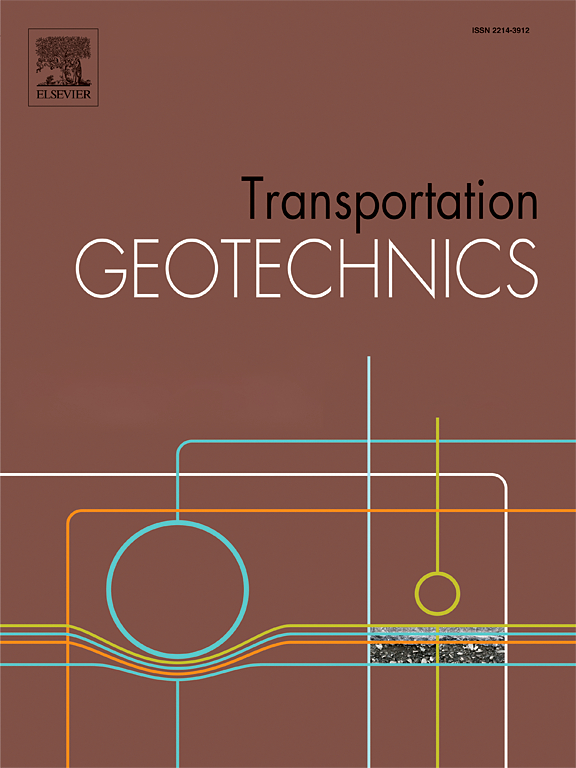Pavement performance analysis considering the influence of suction and temperature on subgrade soil modulus
IF 4.9
2区 工程技术
Q1 ENGINEERING, CIVIL
引用次数: 0
Abstract
Subgrade soils can experience varying suction (equivalent to moisture) and temperature, which could affect the modulus of subgrade soil and the response of flexible pavements. The influence of these two factors on pavement performance has not been explored on purpose despite their importance in a changing climate. In this study, a simple approach was proposed for analyzing pavement performance with consideration of suction and temperature effects on soil modulus. Modulus values at different conditions of suction and temperature are calculated using a semi-empirical equation. Then, they are utilized in the numerical software KENLAYER to evaluate the stress and strain distributions in pavements composed of an asphalt layer, base layer, and subgrade layer based on linear elastic theory. The computed results are used to predict the rutting and fatigue cracking using some field-calibrated semi-empirical equations. In parametric studies using this method, the suction and temperature-dependent modulus of a clayey soil determined from laboratory experiments was applied. The results reveal that an increase in subgrade soil modulus due to drying and cooling can reduce the total rut depth mainly due to a reduction of the vertical compressive strain in the subgrade layer. For instance, a change in suction from 0 to 150 kPa (equivalent to optimum moisture content of the clayey soil) can lead to a 34% decrease in the total rut depth. However, the effects of an increase in soil subgrade modulus on fatigue cracking are influenced by the asphalt thickness. A reduced subgrade modulus because of wetting and heating decreases horizontal tensile strain (less susceptible to fatigue cracking) at the lowest section of relatively thinner asphalt but increases horizontal tensile strain for thicker asphalt.
考虑吸力和温度对路基土模量影响的路面性能分析
基层土壤可能会经历不同的吸力(相当于湿度)和温度,这可能会影响基层土壤的模量和柔性路面的响应。这两个因素对路面性能的影响尽管在不断变化的气候中非常重要,但还没有专门进行过探讨。本研究提出了一种分析路面性能的简单方法,其中考虑了吸力和温度对土壤模量的影响。使用半经验方程计算不同吸力和温度条件下的模量值。然后,利用数值软件 KENLAYER 根据线性弹性理论评估由沥青层、基层和底基层组成的路面的应力和应变分布。计算结果可用于使用一些经过现场校准的半经验方程预测车辙和疲劳开裂。在使用该方法进行参数研究时,应用了实验室实验确定的粘性土的吸力和温度相关模量。研究结果表明,干燥和冷却导致的路基土模量增加可降低总车辙深度,这主要是由于路基层垂直压缩应变的减少。例如,吸力从 0 千帕变为 150 千帕(相当于粘性土的最佳含水量)可导致总车辙深度减少 34%。然而,土壤路基模量的增加对疲劳开裂的影响受沥青厚度的影响。由于湿润和加热而降低的路基模量会降低相对较薄沥青最低部分的水平拉伸应变(不易出现疲劳开裂),但会增加较厚沥青的水平拉伸应变。
本文章由计算机程序翻译,如有差异,请以英文原文为准。
求助全文
约1分钟内获得全文
求助全文
来源期刊

Transportation Geotechnics
Social Sciences-Transportation
CiteScore
8.10
自引率
11.30%
发文量
194
审稿时长
51 days
期刊介绍:
Transportation Geotechnics is a journal dedicated to publishing high-quality, theoretical, and applied papers that cover all facets of geotechnics for transportation infrastructure such as roads, highways, railways, underground railways, airfields, and waterways. The journal places a special emphasis on case studies that present original work relevant to the sustainable construction of transportation infrastructure. The scope of topics it addresses includes the geotechnical properties of geomaterials for sustainable and rational design and construction, the behavior of compacted and stabilized geomaterials, the use of geosynthetics and reinforcement in constructed layers and interlayers, ground improvement and slope stability for transportation infrastructures, compaction technology and management, maintenance technology, the impact of climate, embankments for highways and high-speed trains, transition zones, dredging, underwater geotechnics for infrastructure purposes, and the modeling of multi-layered structures and supporting ground under dynamic and repeated loads.
 求助内容:
求助内容: 应助结果提醒方式:
应助结果提醒方式:


